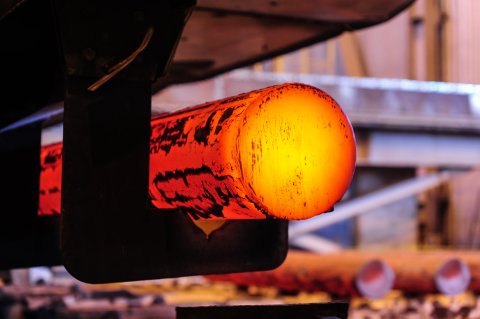With each year, the requirements to quality, reliability and functionality of products made of quality and specialized steel increase. Researchers from South Ural State University and specialists from the Laboratory of Special Metallurgy (Lasmet) are studying a new type of steel which can replace expensive analogs.
Fighting for Quality and Import Substitution
The attention of international machine-building plants has long been focused on boron steels, while Russian plants have been continuing to use low- and medium-alloy steels without boron, losing significant amounts of money. It is not surprising that imported steels are superior to their Russian analogs. Complex research and widespread implementation of sparingly alloyed boron-bearing steels will undoubtedly lead to a significant push forward in the metallurgy industry.
Alexander Maznichevskiy, post graduate student of the Department of Materials Science of the SUSU Polytechnic Institute under the guidance of Professor Yuri Goykhenberg, Doctor of Sciences (Engineering) is researching the interaction of boron with nitrogen in construction and specialized steel.

“Alloyed steel is steel which besides carbon and the typical additives contains other elements improving its quality. At present, interaction of boron with alloying elements, especially with nitrogen has not been fully examined in the engineering literature. This, of course, makes it impossible to use boron-bearing steel alloyed with nitrogen in industry,” says Alexander Maznichevskiy.
The use of small additives of highly-active elements like boron makes it possible to significantly change the characteristics of metal, giving it a range of characteristics that are typical for more alloyed steels. This alternative makes it possible to replace expensive and difficult-to-find alloying elements like chrome, nickel and molybdenum, while preserving the technological and operational properties of steel to a high degree. In addition, the interest in development of technologies for introducing nitrogen to iron-based alloys is increasing. Research of the last few years has shown the significant advantages of high-nitrogen steels as compared to the classic alloyed steels more widely used in industry.
Rational Use of Resources
Research on the interaction between boron and nitrogen in construction and specialized steel, and the use of this resource-saving technology makes it possible to more rationally use resources in metallurgy.
“For the majority of alloying elements, the positive effects on steel are proportional to the amount of the element that’s introduced,” notes Alexander Nikolaevich. “And boron with the introduction of already small amounts of it significantly improves the quality of metal. For example, we see the same growth of hardening like in medium-alloy steels at the concentration of boron 300-500 times less than that of chrome or manganese.”
Boron significantly increases the hardening and mechanical characteristics of steel. However, despite this colossal effect on its characteristics, boron steel can not yet become a full replacement for alloyed steel due to the technological difficulties of manufacturing and the significant instability of its mechanical characteristics. So, South Ural State University researchers have set a difficult task of verifying the practicability of this system of alloying.
From Theory to Practice
“After analysis of data existing in the technical literature, we are planning on choosing a steel composition and creating a series of test smelts. Then we will have to choose samples of deformed metal and study the technical and operational characteristics of steel using modern methods of research – scanning and transmission electronic microscopy, x-ray diffraction analysis, and dilatometric study,” shares his plans the young researcher.
Alexander Maznichevskiy is completing his tests at the Laboratory of Specialized Metallurgy which has the equipment necessary for serious research – smelting and heat-treatment furnaces, an experimental industrial rolling mill, and equipment for mechanical testing of samples and study of the microstructure of metals.
“We have no obvious competitors in this field since small research organizations are not even attempting to solve this issue due to its difficulty. And we can consider large research centers our colleagues who can improve the quality of this research by adding their own openly published data,” explains Alexander Maznichevskiy.
As a result of their successful work, the researchers hope to offer modern Russian industry steel of excellent quality. The consumers of this new product might include businesses in aviation, defense, and atomic industries, where alloyed and highly-alloyed steels are actively used to create unique objects improving both Russian defense capabilities and Russian competitiveness on the international market.
In the near future, the researchers are planning on presenting the obtained results at the Prom-Engineering International Science and Engineering Conference, and are preparing a number of publications for top-ranking international journals: Solid State Phenomena; IOP Conference Series: Materials Science and Engineering; and Materials Science Forum, all indexed at the Scopus database. In addition, Alexander Maznichevskiy’s work was recognized in the Scientific Potential contest held at SUSU under Project 5-100.




